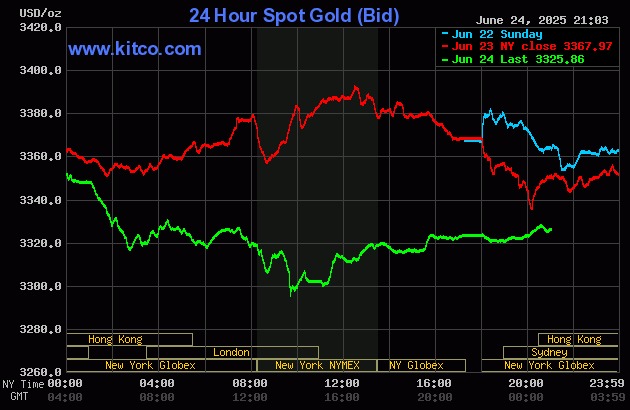Gold closed at 3,322 USD per ounce on 24/6, down 45 USD. During the session, it briefly touched 3,295 USD, its lowest point since 9/6.
"Easing tensions in the Middle East are the main reason for the pressure on gold. Safe-haven demand has decreased. The market is now shifting back to risk assets," said Peter Grant, commodities strategist at Zaner Metals. He believes that the current support level for gold is 3,300 USD per ounce.
 |
World gold prices fell sharply on 24/6. Chart: Kitco |
Global stock markets surged on 24/6, while the USD fell sharply following news of a ceasefire between Israel and Iran. However, US President Donald Trump later stated that both Israel and Iran had violated the ceasefire he brokered.
"There are still some doubts about whether this ceasefire will hold. Until things are clear, I think the potential for further gold price declines is quite limited," Grant commented.
Meanwhile, Federal Reserve (Fed) Chairman Jerome Powell testified before Congress on 24/6 that they need more time to assess the inflationary impact of import tariffs. The Fed is therefore in no hurry to cut interest rates.
The market currently expects the Fed to cut a total of 50 basis points (0.5%) this year, starting in October. Gold prices tend to fall in a low interest rate environment.
Crude oil prices also experienced their second consecutive day of sharp declines as Middle East tensions eased. Brent crude closed at 67.14 USD a barrel on 24/6, down 6%. WTI crude oil fell similarly to 64.3 USD. Earlier in the week, both benchmarks lost 7% as Iran had not yet taken any action to disrupt oil and gas flows in the region.
Yesterday, President Trump also indicated that China may continue buying oil from Iran. This is seen as a signal that the US is easing its maximum pressure strategy on Iran.
Ha Thu (according to Reuters, CNBC)












